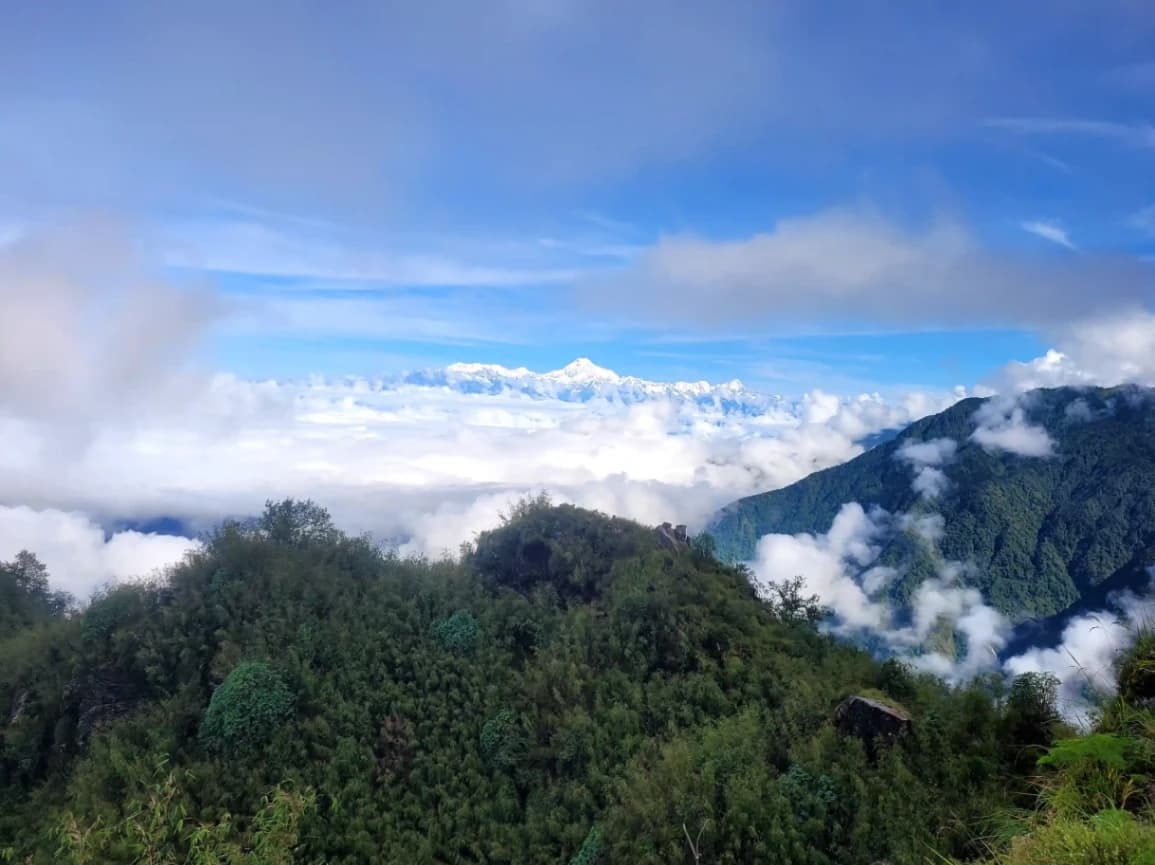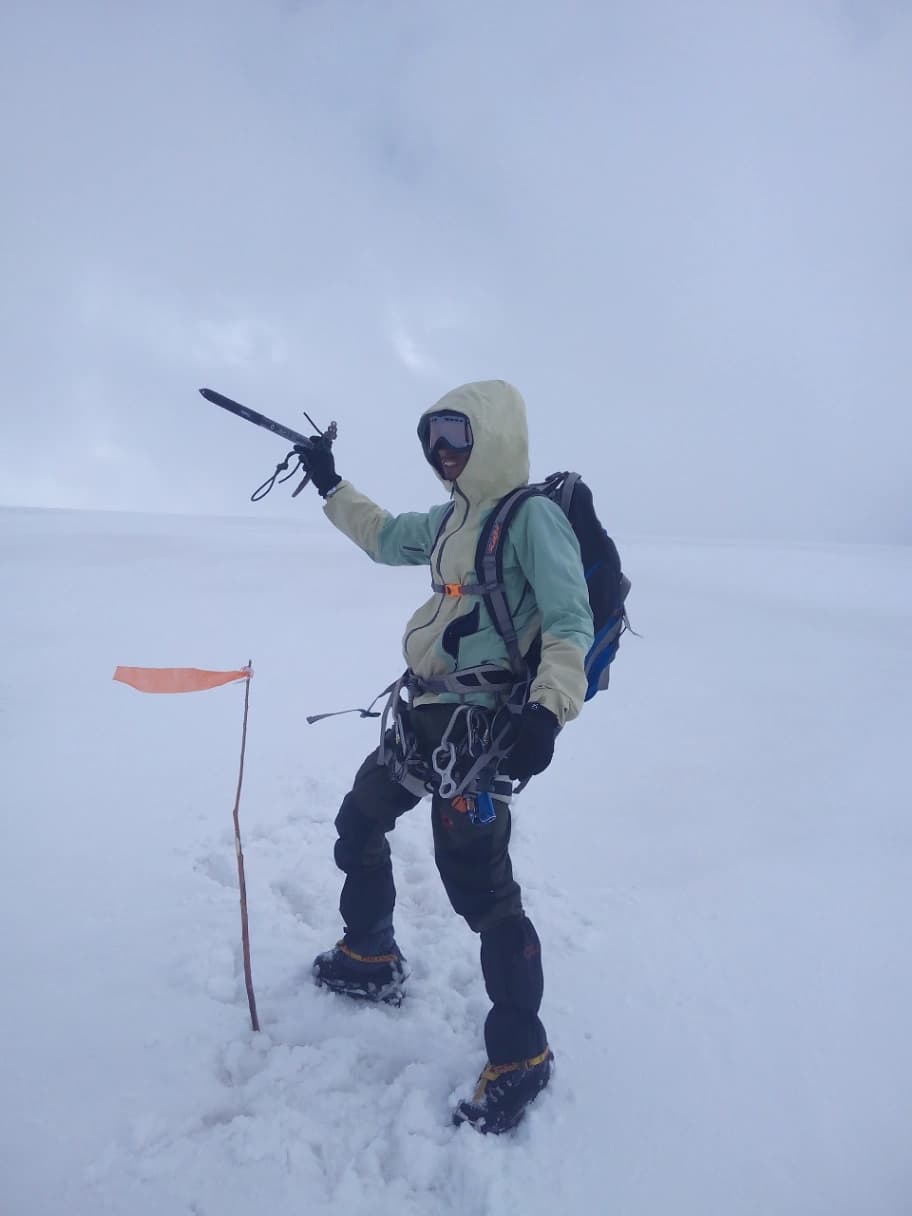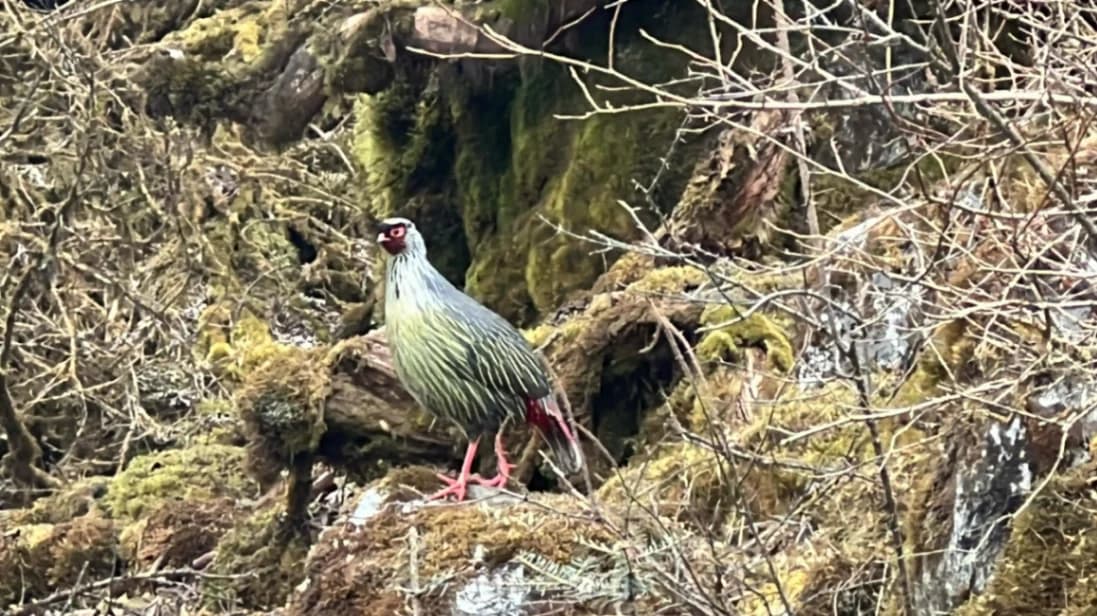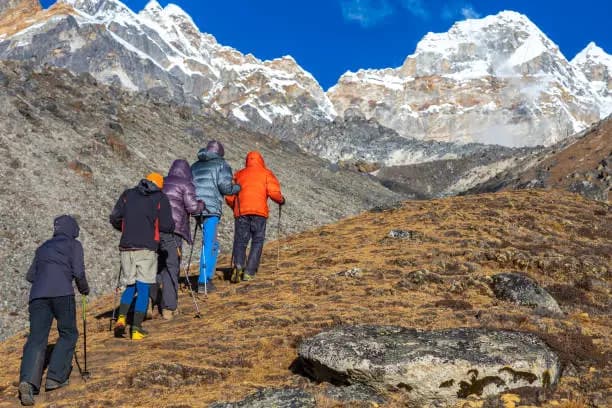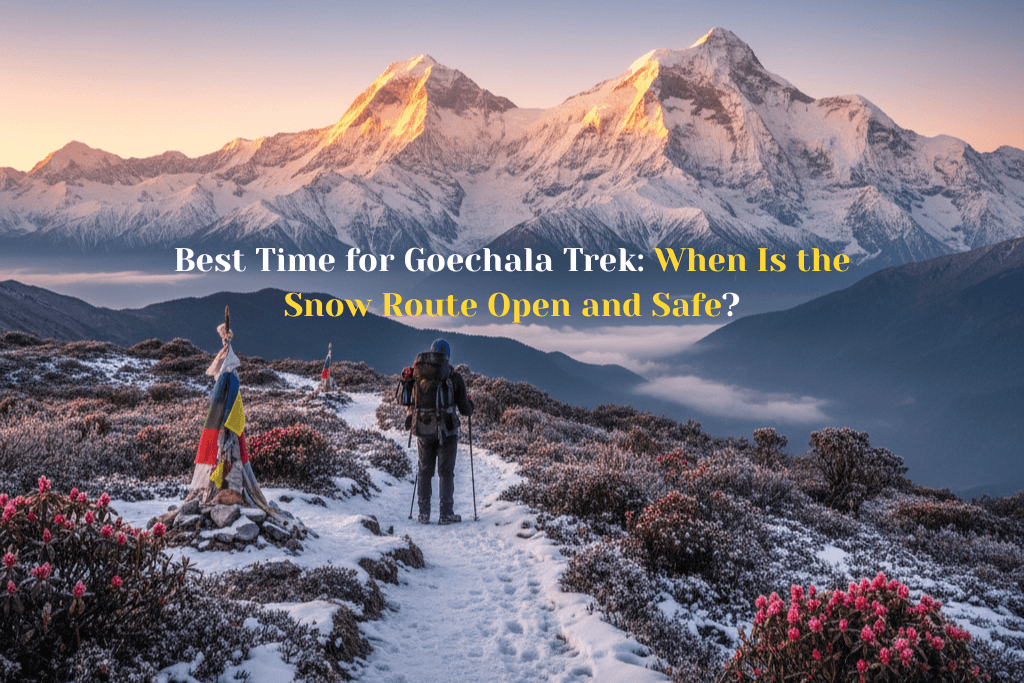The Goechala trek is a popular trek in the Himalayas. It is a trek that provides breathtaking scenery and an opportunity to witness local culture. It is situated in Sikkim, India, and the trek is renowned for its picturesque landscape and abundant wildlife.
Along the way, you’ll encounter thick forests, rivers to cross, and mountain passes to climb. It’s a real adventure for all the nature lovers and individuals who enjoy visiting new destinations.
Key Takeaways
- Goechala trek is a trek in the Himalayas that offers beautiful views and culture.
- The hike takes you along dense forests, over rivers, and through mountain passes.
- Goechala trek is renowned for its stunning landscapes, diverse flora and fauna.
- The hike is a haven for nature lovers and adventure seekers.
- Goechala trek provides an opportunity to witness the local culture of Sikkim.
- The trek provides a unique and exhilarating experience to trekkers.
Introduction to the Magnificent Goechala Trek
The Goechala trek is a stunning experience that provides a rare combination of nature and culture. It is situated in the middle of the Himalayas. This trek lets you experience the stunning landscapes and vibrant culture of the region.
The Goechala trek is a popular destination for trekkers and adventure seekers. Its popularity continues to grow due to its unparalleled beauty and significance.
Some of the key features that make the Goechala trek special include:
- Stunning mountain views and breathtaking landscapes
- Unique cultural experiences and interactions with local communities
- Opportunities to spot rare and exotic wildlife
- Delicious local cuisine and traditional hospitality
The Goechala region is steeped in history and culture. It has remnants of the ancient settlements and trading centers. The significance of the trek is more than natural beauty.
It also provides an opportunity to see the local culture and traditions. Right from vibrant festivals to delectable local cuisine, the Goechala trek is an experience in itself. It is a combination of adventure, nature, and culture.
Whether you are a seasoned trekker or a beginner, the Goechala trek is one that you simply cannot miss. With its stunning scenery, great cultural experiences, and good hospitality, this trek will leave you with memories for a lifetime.
The Best Time to Begin Your Himalayan Adventure
Goecha la trek is a thrilling adventure that assures you of scenic views of the Himalayas. When planning your journey, you need to decide when to go. The trekking season is from March to June and September to November, and each season has a range of experiences to offer.
In spring, from March to May, the goechala trek is covered with rhododendrons in flower and other colorful flowers. It is an excellent time for nature enthusiasts and photographers. Autumn, between September and November, offers clear weather and comfortable temperatures and is best suited for trekking.
- March to May: Spring with rhododendrons and other flowers in bloom
- September to November: Autumn season with clear skies and comfortable temperatures
- June to August: Summer months with monsoon rains, best avoided
It’s necessary to schedule your tour based on the climatic condition and your physical condition. That will be a safe and pleasant tour on the goechala trek.
By deciding on the appropriate time for your goechala trek, you can get the most out of your Himalayan experience. You will have lifelong memories.
Essential Preparations for the Trek
Planning and care are needed for the Goechala trek. Get your body checked and ready. Trekking involves long walks and climbs, so train beforehand for a couple of months.
It is also important to obtain proper documentation. You will need permits and licenses, for which trekking agencies can be of help. Don’t forget your passport, visa, and other identification. Be also properly equipped with the right equipment, like hiking shoes and a first-aid kit.
Physical Fitness Requirements
You have to be physically fit to attempt the goechala trek. Start regular workouts to build up endurance and stamina. A good training regimen will help you survive the challenges of the trek.
Necessary Documentation
It is crucial to have the proper documents. Permits and licenses are required, which can be organized by trekking agencies. Bring a passport, visa, and ID as well.
Permit Information
Getting the right permits is an important part of trek planning. Trekking agencies can help with this. Make sure that you get all your documents in place before you start out.
Complete Day-by-Day Goechala Trek Itinerary
The Goechala trek is an exciting 11-day trek covering a distance of about 90 kilometers. The trek starts at Yuksom, which is the trek base camp. Then you move to Sachen, Tshoka, Dzongri, and Goechala.
Each day of the goechala trek comprises 10-15 kilometers of trekking. You’ll be gaining around 1,000 meters in altitude. Rest days are included in the itinerary to enable you to experience the trek without fatigue.
- Day 1: Arrival in Yuksom
- Day 2-3: Trek to Sachen and Tshoka
- Day 4-5: Trek to Dzongri
- Day 6-7: Trek to Goechala
- Day 8-11: Return journey to Yuksom
The goechala trek offers stunning Himalayan views. It’s a trekker’s paradise and a favorite of adventure lovers. The well-scheduled itinerary and scenic landscape of this trek will give you memories for a lifetime.
Plan properly and book your stay in advance. This will make your goechala trek experience memorable and hassle-free.
Essential Gear and Equipment Checklist
As you embark on the goechala trek, it’s important to have the right things with you. This will make your journey successful and enjoyable. You’ll have to prepare thoroughly and make a checklist of essentials.
Clothing Requirements
Weather at the goechala trek varies considerably. It’s therefore wise to dress in layers. Here’s what you need to bring:
- Base layer: moisture-wicking and breathable clothing
- Fleece jacket: for warmth and insulation
- Waterproof jacket: to keep rain and wind out
Technical Equipment
For the goechala trek, you’ll need some special gear. This includes:
- Trekking poles: for stability and support
- Crampons: for traction on icy surfaces
- Ice axe: for safety and self-arrest
Personal Items
Do not forget personal items like a headlamp and first-aid kit. A water bottle or hydration bladder is also necessary. A portable stove, fuel, and cooking pot are necessary for cooking. And, to camp, you require a tent and sleeping bag.
Weather Conditions and Challenges
The goechala trek is known for its unpredictable weather. The best times to go are spring and autumn, when the weather is clearer. But, always be ready for sudden changes with layers and a waterproof jacket.
Some challenges on the goechala trek include:
- Unpredictable snowstorms
- Landslides
- Steep terrain
- Crossing rivers and streams, which can be challenging during the monsoon season
By following these safety tips and being ready for emergencies, you can have a great goechala trek experience.
The goechala trek is tough and needs you to be in good shape and mentally ready. Know your limits and take steps to stay safe.
Conclusion: Embracing the Goechala Adventure
The Goechala trek is a journey you won’t forget. It combines stunning landscapes, cultural experiences, and personal growth. As you walk the trails, you’ll see breathtaking views of the Himalayas, including Kanchenjunga. This trek changes you, leaving a lasting impact on your heart.
Whether you’re a seasoned trekker or new to high-altitude adventures, the Goechala trek is a chance to explore. You’ll see serene monasteries and meet lively local communities. This trip broadens your view and deepens your respect for different cultures.
Starting this Himalayan journey means facing challenges and enjoying amazing moments. The Goechala trek shows the strength of humans and nature. It invites you to join its eternal story. Get ready to experience the Goechala adventure with all your senses.
FAQ
What is unique about the Goechala trek?
The Goechala trek is special because of its natural beauty and cultural importance. It is located in the midst of the Himalayas, with stunning mountain and valley scenery. The trek is also historically significant, having been a part of the Himalayan trade route.
It provides an opportunity to witness local tradition and culture. This makes the trek more than a nature journey.
When is the best time to do the Goechala trek?
The best season for the Goechala trek varies according to your preference. It is open from March to June and September to November. Spring is ideal for viewing flowers, and autumn is good for clear skies.
Summer should be avoided due to the rain. It complicates the trek. Permits and licenses are needed, which can be arranged through trekking agencies. Bring a passport, visa, and ID. Bring also the appropriate equipment, such as hiking boots and a first-aid kit.
What is the standard Goechala trek itinerary?
The Goechala trek takes 11 days and traverses approximately 90 kilometers. It begins in Yuksom and proceeds to Sachen, Tshoka, Dzongri, and Goechala. The route back is the same, with the option to visit Kanchenjunga Base Camp.
The daily hike is 10-15 kilometers, with a height increase of 1,000 meters.
What are the weather conditions and difficulties that can be anticipated on the Goechala trek?
Weather at the Goechala trek can be unpredictable with snowstorms and landslides. Spring and autumn are the best seasons for more favorable weather. Be ready for changing weather with layers and a waterproof jacket at all times.
Be prepared to cross rivers and streams, which during the monsoon can be challenging. Always check the weather beforehand and be ready for anything.
What are the safety precautions and emergency procedures offered for the Goechala trek?
Safety comes first on the Goechala trek. Altitude sickness, dehydration, and hypothermia are some of the prevalent health issues. Prevent them by hydrating with water, consuming healthy food, and ascending gradually.
Be prepared for emergencies with first-aid kits and contact information. The trekking agency or guide should know what to do during emergencies.





